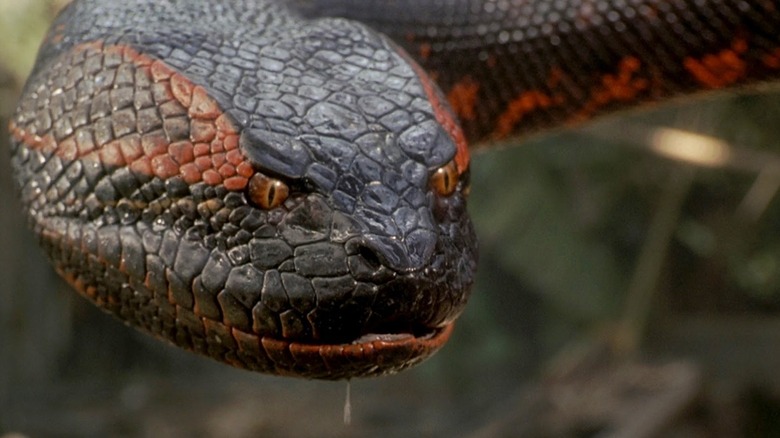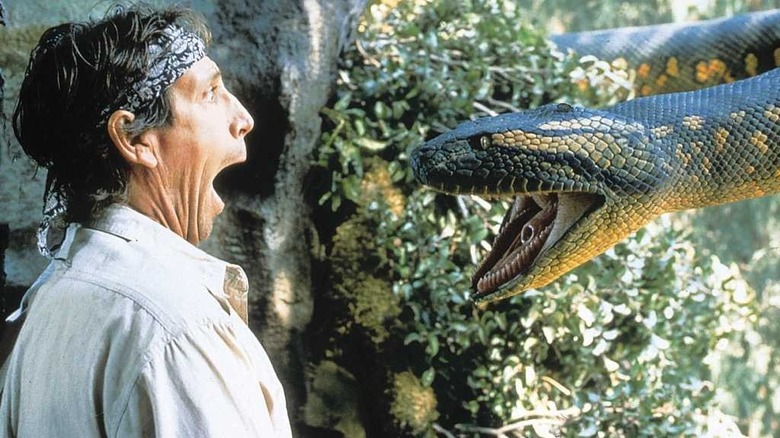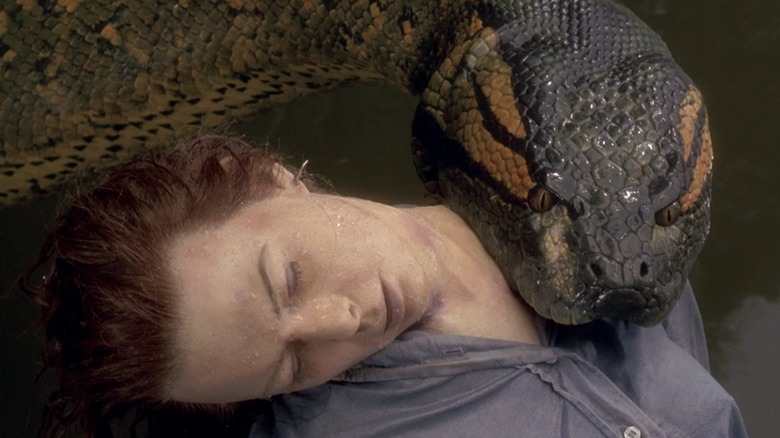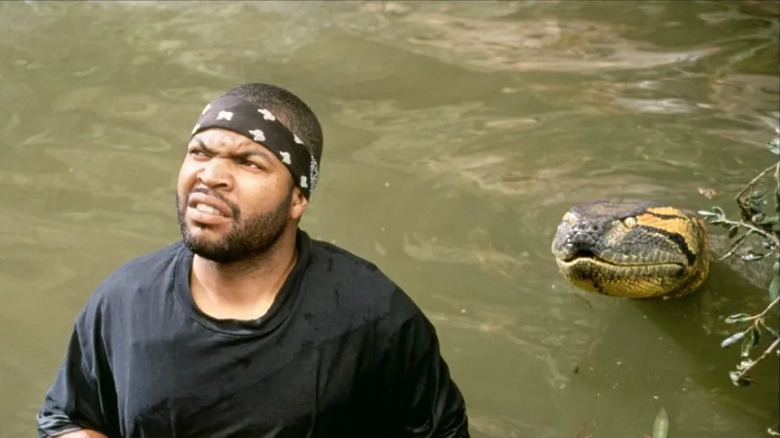Anaconda's Animatronic Snake Wasn't Easy To Work With
Luis Llosa's 1997 creature feature "Anaconda" is one of those rare films that many people saw, but that few people love. Unapologetically reminiscent of monster movies from the 1950s, "Anaconda" was snarfed at by the general public, earning generally negative reviews (it currently holds a 40% approval rating on Rotten Tomatoes) and netting 11 Razzie nominations. It won none of its Razzies, "losing" to films like "The Postman" and "Batman & Robin." One may interpret the losses as a compliment or an insult. Despite the sour reception, "Anaconda" — which starred Jennifer Lopez, Ice Cube, Danny Trejo, Eric Stoltz, Owen Wilson, and Jon Voight — earned a massive $136 million on a mere $45 million budget. It was followed by four sequels, including a "Lake Placid" crossover film wherein the titular snake did battle with a giant crocodile.
The premise of "Anaconda" is about as complex as a cheap animal attack movie might warrant, and bears a few nods to Ruggero Deodato's 1980 gore classic "Cannibal Holocaust." A documentary film crew treks deep into the Amazon to capture a remote, undiscovered (fictional) local tribe called the Shirishamas. On their trip, the crew runs into a Paraguayan snake hunter named Paul (Voight) who has been searching for a 25-foot-long green anaconda. The audience is given a few interesting snake facts that will be pertinent later in the film, notably that anacondas have been known to regurgitate their most recent meal just so it can enjoy the pleasure of eating a second time. This is a comforting assurance to audiences that one character will certainly be swallowed alive and then barfed back up. In that regard "Anaconda" does not disappoint.
My Anaconda don't
Snake facts! The titular constrictor in "Anaconda" was based on a real South American snake which is the largest found on the continent. In real life, they can grow to be about 15 feet in length, although in 2000 — after the release of Llosa's film – Dr. Jesús Antonio Rivas found an anaconda that was 30 feet long and weighed 551 pounds. Anacondas are not venomous.
Set up in 1997, the awesomely rudimentary website Film Scouts detailed the production of "Anaconda," and found that the effects required to visualize a 25-foot snake were difficult to achieve. In some of the longer shots, the snake was animated using CGI, but for closeups, a life-size animatronic snake had to be built. The film's monster builder was Walt Conti who had previously worked on the animatronic animals in "Free Willy" and "Flipper." The main concern with "Anaconda" was that their fake snake had to be able to operate underwater, as there were several scenes of the animal swimming and poking its head through a waterfall.
The animatronic impressed the cast, with Lopez saying "It was scary being in the scene with it, I'd begin to believe it could actually kill me. It looked so real and sometimes it seemed to move by itself." And Stoltz joked that the snake was a prima donna that wouldn't leave its trailer.
Conti's concerns were accurate movements, and creating a realistic, life-size, robotic snake took a lot of study and electronic tools to achieve.
Reticulated, articulated
Of the snake, Conti said he needed to recreate certain snake-like movements to assure that the monster would be convincing, but also scary for a monster movie. Notably, the snake had to be fast as a slow snake wouldn't startle the characters or audiences. He said:
"We basically tried to replicate a real snake ... We tried to give it as many joints as a real snake, figuring that if we gave it enough degrees of movement, we could emulate a snake's moves. We also tried to create a very smooth, undulating motion, but to serve the story we had to be able to do some movements very fast. The suspense and eeriness of the snake comes from its unpredictable nature. You don't know when it is going to strike. So, the snake had to be decisive and quick."
Conti explains that in order to achieve those movements, the animatronic needed 100 separate joints in its body, along with an articulated jaw, eyeballs, and tongue. It was operated by ten puppeteers, each one helming a different part of the snake's body. The general undulating movements Conti mentioned were driven by a pre-programmed computer. When it came to the fast head movements, Conti piloted the snake himself. Conti mentioned that he was particularly proud of the inside of his creature's mouth. "If you're trying to scare someone, the inside of the snake's mouth is a really important thing," he said.
Production wasn't always smooth, however. In a twist that would have made a great horror movie premise in itself, the snake once malfunctioned and began moving on its own.
The surly serpent
Two snakes were built for "Anaconda." A 25-foot version, and a 40-foot version for close-ups. The larger snake weighed over a ton. Actor Ice Cube recalls the time when the robot animal attacked, saying:
"There was this power surge and for a minute, they didn't have control of this thing, which was like 2,000 pounds of momentum, moving like a real snake. It was like fantasy and reality merging. This snake is the best animatronic thing I've ever seen in my life."
The film's executive producer, Susan Ruskin noted that the moment the snake freaked out was like watching a monster having a seizure. Cameras immediately stopped rolling when the crew realized that the snake was out of their control, and they shut it down immediately. Luckily for audiences, however, a portion of the "freak out" was captured on camera and made its way into the final cut of the movie. Keen-eyed viewers might be able to catch the moment when the serpentine thrashing got a little too dramatic.
"Anaconda" is currently available on Tubi, Roku, and Hulu. In 2020, it was announced that a remake of "Anaconda" was in the works, but nothing has yet come to fruition.



